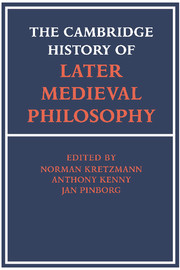 The Cambridge History of Later Medieval Philosophy
The Cambridge History of Later Medieval Philosophy from VIII - Philosophy of mind and action
Published online by Cambridge University Press: 28 March 2008
The Aristotelian origins of the doctrine
The conception of potential and agent intellect came to Western medieval philosophy with the assimilation of Aristotle's theory of soul in his De anima. In this text, intellective cognition was understood as the reception of abstract concepts; therefore Aristotle conceived an intellective power capable of receiving which, in order to accomplish this function, had a purely potential nature. In several passages of the De anima, this power is called nous pathētikos (Lat. intellects possibilis). The process of cognition starts, however, with the data of sensitive cognition, which are particular and not universal. Therefore the reception of abstract concepts must be preceded by the abstraction of the universal content from sensible images. In order to explain this action, Aristotle conceived of an active power which his Greek commentators named nous poietikos (Lat. intellectus agens). Neither the exact functions of the two powers nor the relation between them was very clear in the De anima. In some portions of the text, the intellect was described as a part of the soul, which was defined by Aristotle as a substantial form of the body, but other sections considered the intellect as having a nature different from the soul-form of the body. This difference was especially stressed in the case of the active power, which was at various points described as being separate from the body and surviving death, or as inseparably joined to the body. These and other inconsistencies in Aristotle's text opened the way to different interpretations beginning with such Greek commentators as Themistius and Alexander of Aphrodisias, and carrying on through medieval Arabic ‘Aristotelian’ theories of the soul.
To save this book to your Kindle, first ensure no-reply@cambridge.org is added to your Approved Personal Document E-mail List under your Personal Document Settings on the Manage Your Content and Devices page of your Amazon account. Then enter the ‘name’ part of your Kindle email address below. Find out more about saving to your Kindle.
Note you can select to save to either the @free.kindle.com or @kindle.com variations. ‘@free.kindle.com’ emails are free but can only be saved to your device when it is connected to wi-fi. ‘@kindle.com’ emails can be delivered even when you are not connected to wi-fi, but note that service fees apply.
Find out more about the Kindle Personal Document Service.
To save content items to your account, please confirm that you agree to abide by our usage policies. If this is the first time you use this feature, you will be asked to authorise Cambridge Core to connect with your account. Find out more about saving content to Dropbox.
To save content items to your account, please confirm that you agree to abide by our usage policies. If this is the first time you use this feature, you will be asked to authorise Cambridge Core to connect with your account. Find out more about saving content to Google Drive.